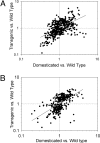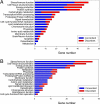Domestication and growth hormone transgenesis cause similar changes in gene expression in coho salmon (Oncorhynchus kisutch)
- PMID: 19223591
- PMCID: PMC2651260
- DOI: 10.1073/pnas.0809798106
Domestication and growth hormone transgenesis cause similar changes in gene expression in coho salmon (Oncorhynchus kisutch)
Abstract
Domestication has been extensively used in agricultural animals to modify phenotypes such as growth rate. More recently, transgenesis of growth factor genes [primarily growth hormone (GH)] has also been explored as a rapid approach to accelerating performance of agricultural species. Growth rates of many fishes respond dramatically to GH gene transgenesis, whereas genetic engineering of domestic mammalian livestock has resulted in relatively modest gains. The most dramatic effects of GH transgenesis in fish have been seen in relatively wild strains that have undergone little or no selection for enhanced growth, whereas genetic modification of livestock necessarily has been performed in highly domesticated strains that already possess very rapid growth. Such fast-growing domesticates may be refractory to further stimulation if the same regulatory pathways are being exploited by both genetic approaches. By directly comparing gene expression in wild-type, domestic, and GH transgenic strains of coho salmon, we have found that domestication and GH transgenesis are modifying similar genetic pathways. Genes in many different physiological pathways show modified expression in domestic and GH transgenic strains relative to wild-type, but effects are strongly correlated. Genes specifically involved in growth regulation (IGF1, GHR, IGF-II, THR) are also concordantly regulated in domestic and transgenic fish, and both strains show elevated levels of circulating IGF1. Muscle expression of GH in nontransgenic strains was found to be elevated in domesticated fish relative to wild type, providing a possible mechanism for growth enhancement. These data have implications for genetic improvement of existing domesticated species and risk assessment and regulation of emerging transgenic strains.
Conflict of interest statement
The authors declare no conflict of interest.
Figures




Similar articles
-
Effect of growth rate on transcriptomic responses to immune stimulation in wild-type, domesticated, and GH-transgenic coho salmon.BMC Genomics. 2019 Dec 27;20(1):1024. doi: 10.1186/s12864-019-6408-4. BMC Genomics. 2019. PMID: 31881844 Free PMC article.
-
Growth hormone transgenesis in coho salmon disrupts muscle immune function impacting cross-talk with growth systems.J Exp Biol. 2018 Jul 4;221(Pt 13):jeb173146. doi: 10.1242/jeb.173146. J Exp Biol. 2018. PMID: 29700060
-
Endocrine effects of growth hormone overexpression in transgenic coho salmon.Gen Comp Endocrinol. 2008 Oct;159(1):26-37. doi: 10.1016/j.ygcen.2008.07.011. Epub 2008 Aug 5. Gen Comp Endocrinol. 2008. PMID: 18713628
-
Control of growth hormone synthesis.Domest Anim Endocrinol. 1996 Jan;13(1):1-33. doi: 10.1016/0739-7240(95)00059-3. Domest Anim Endocrinol. 1996. PMID: 8625613 Review.
-
Continuous light (relative to a 12:12 photoperiod) has no effect on anxiety-like behaviour, boldness, and locomotion in coho salmon (Oncorhynchus kisutch) post-smolts in recirculating aquaculture systems at a salinity of either 2.5 or 10 ppt.Comp Biochem Physiol A Mol Integr Physiol. 2022 Jan;263:111070. doi: 10.1016/j.cbpa.2021.111070. Epub 2021 Sep 10. Comp Biochem Physiol A Mol Integr Physiol. 2022. PMID: 34509593 Review.
Cited by
-
Introgression of domesticated alleles into a wild trout genotype and the impact on seasonal survival in natural lakes.Evol Appl. 2012 Jan;5(1):76-88. doi: 10.1111/j.1752-4571.2011.00210.x. Epub 2011 Oct 24. Evol Appl. 2012. PMID: 25568031 Free PMC article.
-
Is there a risk from not using GE animals?Transgenic Res. 2010 Jun;19(3):357-61. doi: 10.1007/s11248-009-9341-5. Epub 2009 Nov 4. Transgenic Res. 2010. PMID: 19888667 Free PMC article. No abstract available.
-
Comparing genomic signatures of domestication in two Atlantic salmon (Salmo salar L.) populations with different geographical origins.Evol Appl. 2018 Dec 7;12(1):137-156. doi: 10.1111/eva.12689. eCollection 2019 Jan. Evol Appl. 2018. PMID: 30622641 Free PMC article.
-
Acute physiological stress down-regulates mRNA expressions of growth-related genes in coho salmon.PLoS One. 2013 Aug 19;8(8):e71421. doi: 10.1371/journal.pone.0071421. eCollection 2013. PLoS One. 2013. PMID: 23990952 Free PMC article.
-
Comparison of muscle structure and transcriptome analysis of eyed-side muscle and blind-side muscle in Cynoglossussemilaevis (Osteichthyes, Cynoglossidae).Zookeys. 2025 Mar 6;1230:213-229. doi: 10.3897/zookeys.1230.139837. eCollection 2025. Zookeys. 2025. PMID: 40093692 Free PMC article. Review.
References
-
- Diamond J. Evolution, consequences and future of plant and animal domestication. Nature. 2002;418:700–707. - PubMed
-
- Lawrence TLJ, Fowler VR. Growth of Farm Animals. Oxford, UK: CABI; 2002.
-
- Doebley J, Gaut B, Smith B. The molecular genetics of crop domestication. Cell. 2006;127:1309–1321. - PubMed
-
- Korol AS, Cnaani A, Hallerman EM. In: Aquaculture Genome Technologies. Liu ZJ, editor. Ames, IA: Blackwell; 2007. pp. Pages 169–197.
-
- Devlin RH, et al. Extraordinary salmon growth. Nature. 1994;371:209–210.
Publication types
MeSH terms
Substances
Associated data
- Actions
LinkOut - more resources
Full Text Sources
Molecular Biology Databases
Miscellaneous

